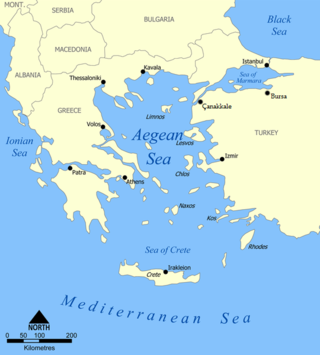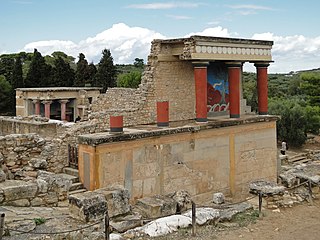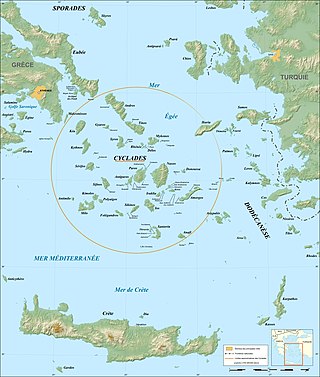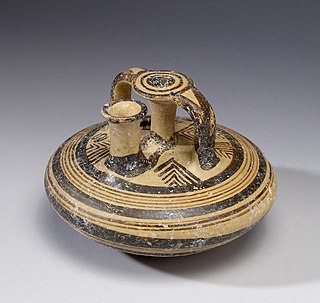
The Aegean Sea is an elongated embayment of the Mediterranean Sea between Europe and Asia. It is located between the Balkans and Anatolia, and covers an area of some 215,000 km2 (83,000 sq mi). In the north, the Aegean is connected to the Marmara Sea, which in turn connects to the Black Sea, by the straits of the Dardanelles and the Bosphorus, respectively. The Aegean Islands are located within the sea and some bound it on its southern periphery, including Crete and Rhodes. The sea reaches a maximum depth of 2,639 m (8,658 ft) to the west of Karpathos. The Thracian Sea and the Sea of Crete are main subdivisions of the Aegean Sea.

Aegean civilization is a general term for the Bronze Age civilizations of Greece around the Aegean Sea. There are three distinct but communicating and interacting geographic regions covered by this term: Crete, the Cyclades and the Greek mainland. Crete is associated with the Minoan civilization from the Early Bronze Age. The Cycladic civilization converges with the mainland during the Early Helladic ("Minyan") period and with Crete in the Middle Minoan period. From c. 1450 BC, the Greek Mycenaean civilization spreads to Crete, probably by military conquest. The earlier Aegean farming populations of Neolithic Greece brought agriculture westward into Europe before 5,000 BC.

Linear A is a writing system that was used by the Minoans of Crete from 1800 BC to 1450 BC. Linear A was the primary script used in palace and religious writings of the Minoan civilization. It was succeeded by Linear B, which was used by the Mycenaeans to write an early form of Greek. It was discovered by the archaeologist Sir Arthur Evans in 1900. No texts in Linear A have yet been deciphered. Evans named the script "Linear" because its characters consisted simply of lines inscribed in clay, in contrast to the more pictographic characters in Cretan hieroglyphs that were used during the same period.

Linear B is a syllabic script that was used for writing in Mycenaean Greek, the earliest attested form of the Greek language. The script predates the Greek alphabet by several centuries, the earliest known examples dating to around 1400 BC. It is adapted from the earlier Linear A, an undeciphered script potentially used for writing the Minoan language, as is the later Cypriot syllabary, which also recorded Greek. Linear B, found mainly in the palace archives at Knossos, Kydonia, Pylos, Thebes and Mycenae, disappeared with the fall of Mycenaean civilization during the Late Bronze Age collapse. The succeeding period, known as the Greek Dark Ages, provides no evidence of the use of writing.

The Minoan civilization was a Bronze Age culture which was centered on the island of Crete. Known for its monumental architecture and energetic art, it is often regarded as the first civilization in Europe. The ruins of the Minoan palaces at Knossos and Phaistos are popular tourist attractions.

Knossos is a Bronze Age archaeological site in Crete. The site was a major center of the Minoan civilization and is known for its association with the Greek myth of Theseus and the minotaur. It is located on the outskirts of Heraklion, and remains a popular tourist destination.

Phaistos, also transliterated as Phaestos, Festos and Latin Phaestus, is a Bronze Age archaeological site at modern Faistos, a municipality in south central Crete. It is notable for the remains of a Minoan palace and the surrounding town.

The Greek Dark Ages, were earlier regarded as two continuous periods of Greek history: the Postpalatial Bronze Age and the Prehistoric Iron Age or Early Iron Age, which included all the ceramic phases from the Protogeometric to the Middle Geometric I and lasted until the beginning of the Protohistoric Iron Age around 800 BC. Currently, the term Greek Dark Ages is being abandoned, and both periods are not considered "obscure."

Cycladic culture was a Bronze Age culture found throughout the islands of the Cyclades in the Aegean Sea. In chronological terms, it is a relative dating system for artifacts which serves as a roughly contemporary dating system to Helladic chronology and Minoan chronology (Crete) during the same period of time.

Mycenaean Greece was the last phase of the Bronze Age in ancient Greece, spanning the period from approximately 1750 to 1050 BC. It represents the first advanced and distinctively Greek civilization in mainland Greece with its palatial states, urban organization, works of art, and writing system. The Mycenaeans were mainland Greek peoples who were likely stimulated by their contact with insular Minoan Crete and other Mediterranean cultures to develop a more sophisticated sociopolitical culture of their own. The most prominent site was Mycenae, after which the culture of this era is named. Other centers of power that emerged included Pylos, Tiryns, and Midea in the Peloponnese, Orchomenos, Thebes, and Athens in Central Greece, and Iolcos in Thessaly. Mycenaean settlements also appeared in Epirus, Macedonia, on islands in the Aegean Sea, on the south-west coast of Asia Minor, and on Cyprus, while Mycenaean-influenced settlements appeared in the Levant and Italy.

Helladic chronology is a relative dating system used in archaeology and art history. It complements the Minoan chronology scheme devised by Sir Arthur Evans for the categorisation of Bronze Age artefacts from the Minoan civilization within a historical framework. Whereas Minoan chronology is specific to Crete, the cultural and geographical scope of Helladic chronology is confined to mainland Greece during the same timespan. Similarly, a Cycladic chronology system is used for artifacts found in the Aegean islands. Archaeological evidence has shown that, broadly, civilisation developed concurrently across the whole region and so the three schemes complement each other chronologically. They are grouped together as "Aegean" in terms such as Aegean art and, rather more controversially, Aegean civilization.

Minoan pottery has been used as a tool for dating the mute Minoan civilization. Its restless sequence of quirky maturing artistic styles reveals something of Minoan patrons' pleasure in novelty while they assist archaeologists in assigning relative dates to the strata of their sites. Pots that contained oils and ointments, exported from 18th century BC Crete, have been found at sites through the Aegean islands and mainland Greece, in Cyprus, along coastal Syria and in Egypt, showing the wide trading contacts of the Minoans.

Hagia Triada, is a Minoan archaeological site in Crete. The site includes the remains of an extensive settlement noted for its monumental NeoPalatial and PostPalatial period buildings especially the large Royal Villa. It is located in the Mesara Plain about three kilometers from the larger Palace of Phaistos, with which it appears to have had close political and economic ties. It is also nearby the Minoan harbor site of Kommos. Excavations at Hagia Triada have provided crucial evidence concerning Minoan everyday life.

Gareth Alun Owens is a British-Greek academic, currently serving as Associate Director and «Erasmus/Socrates» Manager/Tutor of the International Relations Office of the Hellenic Mediterranean University and as Associate Professor of Hellenic Culture -- History, Language and Civilization. He is notable for his contributions to Linear B studies and for his attempts to coordinate the efforts of academics to decipher Linear A.

Mycenaean pottery is the pottery tradition associated with the Mycenaean period in Ancient Greece. It encompassed a variety of styles and forms including the stirrup jar. The term "Mycenaean" comes from the site Mycenae, and was first applied by Heinrich Schliemann.

A stirrup jar is a type of pot associated with the culture of Mycenaean Greece. They have small squat bodies, a pouring spout, and a second nonfunctioning spout over which the handles connect like a stirrup. During the Late Bronze Age, they were used in the export of oils, and are found in large numbers at sites around the Eastern Mediterranean and beyond. The term "stirrup-jar" is a translation of German "Bügelkanne", the name assigned to them by Heinrich Schliemann who found the first instances during his excavations at Troy.
Malcolm H. Wiener is an American attorney, prehistorian and philanthropist. Most notably, Wiener has served as general counsel of the Archaeological Institute of America, as an advisor for the United States Department of State and as principal and chairman of The Millburn Corporation and ShareInVest, both investment management firms.
Emmett Leslie Bennett Jr. was an American classicist and philologist whose systematic catalog of its symbols led to the solution of reading Linear B, a 3,300-year-old syllabary used for writing Mycenaean Greek hundreds of years before the Greek alphabet was developed. Archaeologist Arthur Evans had discovered Linear B in 1900 during his excavations at Knossos on the Greek island of Crete and spent decades trying to comprehend its writings until his death in 1941. Bennett and Alice Kober cataloged the 80 symbols used in the script in his 1951 work The Pylos Tablets, which provided linguist John Chadwick and amateur scholar Michael Ventris with the vital clues needed to finally decipher Linear B in 1952.

Marie-Louise Bech Nosch is a Professor in the University of Copenhagen and an expert in the interdisciplinary study of prehistoric textiles. Her main research focus is on the evidence for textile production in Mycenaean Greece provided by the Linear B tablets; she has also published widely on the cross-cultural study of textiles from across the ancient Mediterranean and Near East.
Anna Sacconi is an Italian Professor Emeritus of Aegean civilisation at La Sapienza, University of Rome. She is known for her work on the corpus of Linear B vase inscriptions and Linear B tablets from Thebes.













